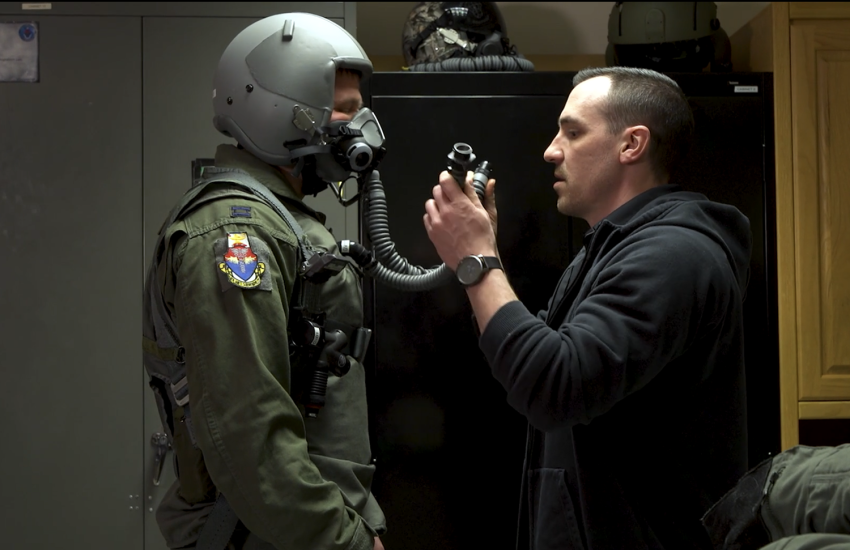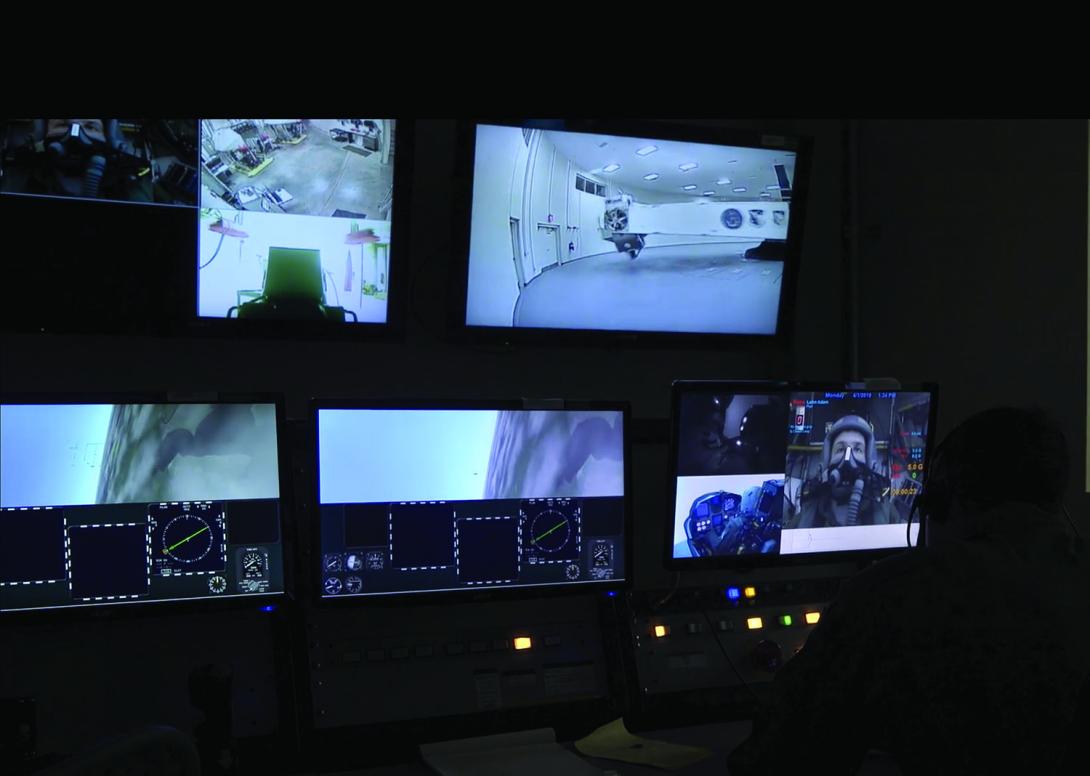Whole Warriors Could Be the Differentiators
Scientists at the Air Force Research Laboratory (AFRL), in the lab’s 711th Human Performance Wing, are finding ways to improve the performance of airmen and Guardians. The lab is investing heavily in developing new technologies that can help the warfighters overcome the negative effects of stress, fatigue and workload, and improve their attention, arousal from sleep, multitasking and decision-making skills so they can perform at their best in the fog of war.
U.S. adversaries such as China already have or will have an equal footing with the United States as far as technology, so it is important to consider the so-called whole warrior, not only supporting a warfighter’s physical fitness but also their mental and cognitive fitness.
“We know that our adversaries are making rapid advancements in technology,” said Gaurav Sharma, primary advisor to the 711th Human Performance Wing (HPW) commander, Brig. Gen. Robert Bogart. “So, it will not come as a surprise that we will soon find ourselves in a world of technological parity. And it will be our warfighters who will provide us with a strategic advantage over our adversaries in a conflict. With our warfighters as our most valuable asset, it’s very important that we take a more holistic, whole warrior approach.”
Sharma, a biomedical engineer who has specialized in robotics, drug delivery, neurotechnology and medical device development in industry and academia, serves as the primary authority for the Wing’s research portfolio. He ensures the quality of the scientific research and its operational relevance to warfighters. Sharma provides scientific advice, technical guidance and mentoring to about 2,000 711 HPW employees
“I would say that over the last few years, we have been focusing more on the cognitive, mind aspect of warfighter performance,” the chief scientist offered. Any performance support needs to enable, enhance, sustain and restore airmen and Guardians throughout the life cycle of their whole career, he stressed.
Given the military’s enduring personal fitness requirements, one of the studies at the lab is examining alternative ways to improve the physicality of warfighters. Launched in May, the two-year study for the U.S. Space Force, the Continuous Fitness Assessment, involves about 6,000 Guardians.
“The annual PT test that the Guardians do can sometimes lead to not-so-healthy behaviors such as exercise cramming, anxiety and can lead to increased injuries,” the chief scientist stated. “This study will examine the long-term effects the continuous physical fitness assessments have on the physical behavior and performance of Guardians. As part of this study, a team from our Human Effectiveness Directorate in the 711 Human Performance Wing is testing out a 21st-century alternative solution to the annual physical test that the Guardians have to do.”
The project’s research team includes a whole range of specialists: psychologists, exercise physiologists, computer scientists, engineers, athletic trainers and program managers. The associated technology solution incorporates the latest in wearable technology, cybersecurity and software platforms.
“This is a combination of more than a decade of work across AFRL and especially within the 711th, where we developed and tested new wearable devices, validated the metrics that are most relevant for the performance and health assessments, and identified the cybersecurity measures, along with developing databases and algorithms that helped to enable the study,” the chief scientist explained.
Since personally identifiable information is involved, the advanced cybersecurity protocols have to address where the Guardians’ data will be stored, who will have access to the data, what kind of data is pulled and what information the participants can see versus a unit’s commander, for example.
The project also relies on the latest in wearable technologies, pulling in advancements from other departments in the lab, Sharma continued. “We have several projects within the 711th Wing where we are looking at developing new wearable sensors, such as interstitial fluid monitoring where we can get a wearable patch to detect the level of different compounds just under the skin that can be relevant to measuring our fatigue or stress and our performance,” he said. “We are also partnering with our Materials and Manufacturing Directorate, looking at new material solutions for developing those sensors.”
After two years of data collection, the researchers will analyze the information to see if doing a long-term fitness assessment with Guardians is beneficial rather than an annual physical test, Sharma stated.
“Since we proposed and launched this study with the Space Force, it has been a big hit with the Guardians,” Sharma stated. “And remember, this is a completely voluntary study. Our team hopes that with the better tracking of exercise habits over a longer duration of time, it will lead to a more consistent fitness level with fewer injuries.”
Another effort at the lab involves a partnership with NASA, testing the crew equipment for the upcoming Artemis II mission that will send astronauts back to the moon.
AFRL has a long history of working with NASA, from the 1950s when it performed physiological, psychological and biomedical tests on the candidates for the first human space flight program in the United States, Project Mercury.
For the present-day project, the lab is using the Horizontal Impact Accelerator, which is only one of two or three of its kind in the world that has the capability to conduct such extensive biodynamic research, the chief scientist said. The Biodynamics Group at AFRL recently tested NASA’s most current astronaut crew seat and flight suits that will be used on the Orion space capsule in the Artemis Mission in the Horizontal Impact Accelerator at AFRL’s Biomedical Impact of Flight Branch.
“Some of the challenges that NASA is facing with these space missions is when the astronauts are coming back and reentering Earth’s atmosphere, they are subjected to extreme conditions,” Sharma explained. “Those are also some of the challenges that our Air Force pilots face when they go on missions—high Gs [gravitational forces] and altitude.”

By working with NASA, the lab hopes to get data on how best to design Air Force protective equipment, life support systems, “and just study the human physiology in more detail,” he added. “I would say it is a win-win for both the organizations.”
Meanwhile, another effort involves cognitive neuroscience and basic research into brain-machine interfaces. The project examines the potential of individual neural learning systems known as I-Neuros and the possibility of accelerating learning through monitoring and enhancing cognitive states. For Sharma, it draws a comparison to a Hollywood sci-fi movie plot.
“If you remember the movie ‘The Matrix,’ you will remember that Neo was plugged into the Matrix with a brain-machine interface,” Sharma said. “Neo has information downloaded into his brain, and he opens his eyes, and he suddenly knows Kung Fu. He is able to fight because he has learned to do so through a brain-machine interface. We are not quite doing that, but we are doing something similar.”
The goal of the lab’s project is to use brain-machine interfaces to read into the cognitive state of an Air Force pilot or another participant to find out when they are in a most optimal state to accept learning and internalize the knowledge.
“This project is meant to expedite pilot training and how can we train the pilots to learn the skills faster,” the chief scientist emphasized. “And if they are not in that optimal state, how can we use a noninvasive safe neuromodulation, such as a little wave of stimulation on their neck to get them into that optimal state.”
Once a pilot is in an optimal learning state, they receive instruction or information for a task through virtual reality or augmented reality to learn it faster.
In addition, the research into the novel new brain-machine interface technologies—which the chief scientist considers high risk, high reward—relies heavily on the artificial intelligence systems the lab is advancing.
“Obviously, there is a high dose of AI in there,” Sharma stated. “How do we decode the brain state? How do we develop a closed-loop system to do neuromodulation? And our goal is that this technology will help us expedite pilot training by at least 35% over the current state. And then, if we are successful in that, hopefully, we can even improve that more in the future.”
Naturally, a degree of trust between a pilot and a machine is required. Here, Sharma pulls in insights from the lab’s Human Machine Teaming Group within the Warfighter Interaction Division, which has a “sizable program” examining trustworthiness and decision-making. The researchers are investigating issues such as how humans make decisions when a team member is a machine and when to give machines the autonomy to make decisions on a human’s behalf.
The researchers also want to have machines provide more information about the state of pilots, for both physical and cognitive states. “Maybe the operator or the human is fatigued and is not able to make the right decision,” he ventured. “Can the machine know that through these physiological and cognitive sensors and then maybe make decisions on our behalf? We don’t have the answers for that now, but this is a very, very active area of research for us, realizing that in the future humans and machines will be fighting together.”
For Sharma, it is all about how supporting the human and improving performance, no matter what level of robot or computer interaction.
“When we are interacting with technology, we are humans,” he noted. “We are not robots. We react with our emotions and our biases. They all come into play, even with human-to-human interaction. That’s what makes the human so unique and capable. It is that individuality. And it is that adaptation that makes us better than machines.”




Comments